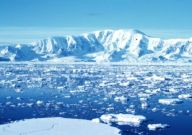Science & Technology
January 10, 2012 · 59 comments
59 comments

Image Credit: NOAA
Source: Daily Mail | Comments (59)
Human carbon emissions could delay ice age
By T.K. RandallJanuary 10, 2012 ·
 59 comments
59 comments
Image Credit: NOAA
Scientists believe the next big ice age could be delayed for years thanks to human carbon emissions.
Another ice age is expected within the next 1500 years however thanks to global warming it might not even happen at all. "It's an interesting philosophical discussion," said Cambridge University paleoclimatologist Luke Skinner. "Would we better off in a warm world rather than a glaciation? Probably we would." At a time when the concept of climate change has been receiving nothing but negative press could the idea of global warming actually be a blessing in disguise ?Cambridge university scientists say that a new Ice Age is due to start within 1,500 years. But due to human carbon emissions, the lethal 'big freeze' could be put off.
Source: Daily Mail | Comments (59)

The Unexplained Mysteries
Book of Weird News
AVAILABLE NOW
Take a walk on the weird side with this compilation of some of the weirdest stories ever to grace the pages of a newspaper.
Click here to learn more

Support us on Patreon
BONUS CONTENTFor less than the cost of a cup of coffee, you can gain access to a wide range of exclusive perks including our popular 'Lost Ghost Stories' series.
Click here to learn more
Extraterrestrial Life and The UFO Phenomenon
Ancient Mysteries and Alternative History
Russia and the War in Ukraine
Metaphysics and Psychic Phenomena
Total Posts: 7,608,206 Topics: 316,493 Members: 201,859
Not a member yet ? Click here to join - registration is free and only takes a moment!
Not a member yet ? Click here to join - registration is free and only takes a moment!





















Please Login or Register to post a comment.